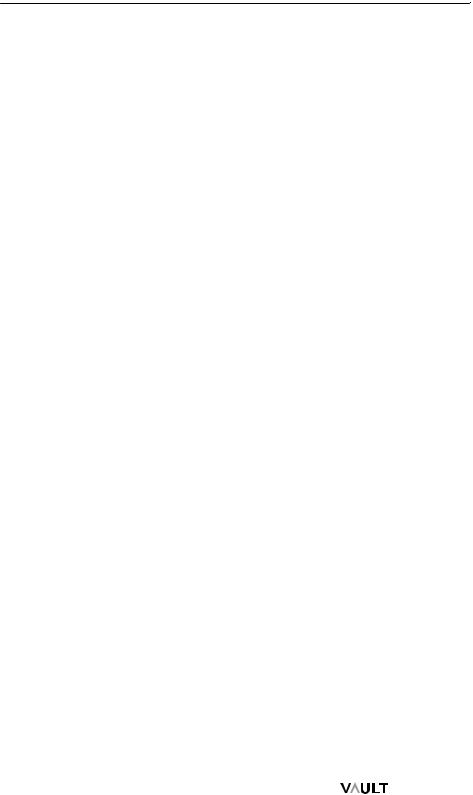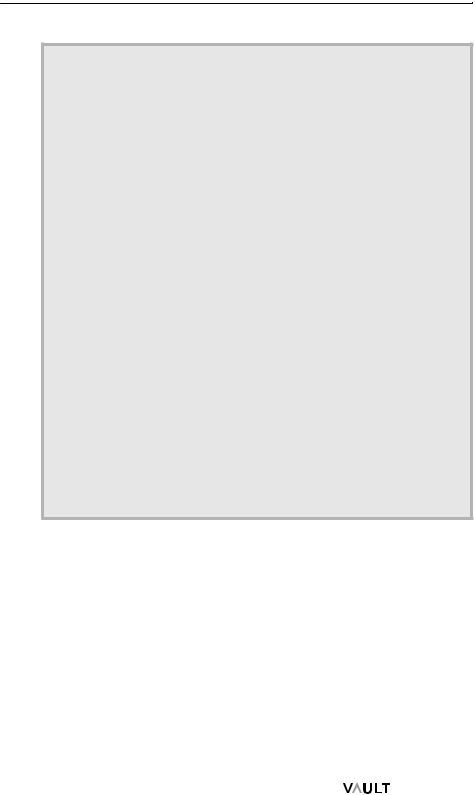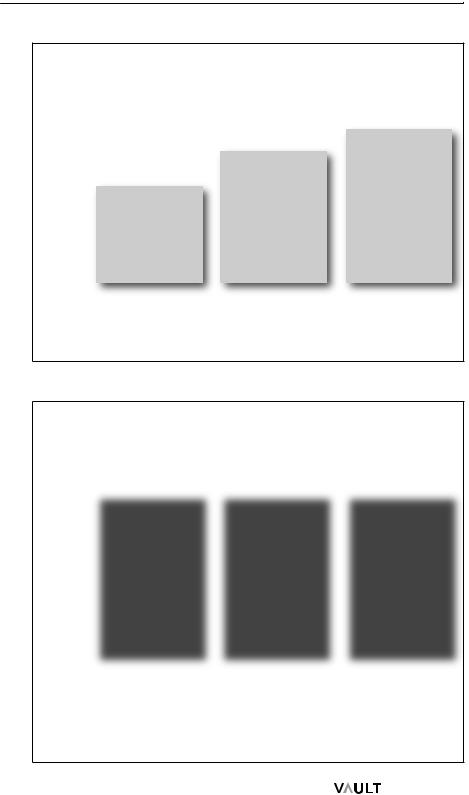
Vault_2-_Cases
.pdf
Vault Case Interview Practice Guide 2: More Case Interviews
Introduction
fullest, have someone else play the interviewer and give you the cases. Even better, have someone that you don’t know that well play your interviewer. If you only practice cases with your best friends with whom you’re likely very comfortable, you won’t simulate the experience of having a case interviewer you don’t know well giving you cases.
Finally, another good thing to practice is your elementary school math. Most people preparing for interviews have not done math without a calculator since third grade; so, your skills of doing math with pen and paper are likely a little rusty. The best remedy is to take out a pen and white paper and practice a little old-fashioned multiplication and long division for a few hours one afternoon. You’ll find that it’s like riding a bicycle, but you’ll be happy you got back on the bicycle before your interview day.
Practicing “non-case” part of interviews
You will spend a majority of your time practicing case interviews—and this is probably where you should spend a majority of your time. However, if you haven’t interviewed in a while (case interviewed or otherwise), it’s recommended that you spend some time practicing the non-case part of case interviews as well. Everyone can get a little rusty and would benefit from a little warming up before going back into the interviewing world. Furthermore, because the non-case part of a case interview is supposed to reinforce many of the skills shown in the case, it’s advisable to practice this part, too, as a solid get- to-know-you interview can make or break your chances for the next round of a top-tier consulting interview. (Remember: They’re evaluating you for what you’ll look like in front of a client, as much as your Excel or data analysis skills.)
Visit the Vault Consulting Career Channel at www.vault.com/consulting — with insider firm profiles, message boards, the Vault Consulting Job Board and more.
L I B R A R Y |
11 |
C A R E E R |
|

Vault Case Interview Practice Guide 2: More Case Interviews
Introduction
Case Interview Categories
Guesstimates/brainteasers
These are short math problems that some consulting firms use, instead of a case, in order to assess an applicant’s quantitative abilities, structured thinking and creativity with data. They tend to be rather silly “sizing” questions, but they’re a good way to practice the thinking skills that you need to be fluent in the case without having to practice a whole case. (An appendix of examples of these types of questions is included on page 177.)
Market sizing
A market sizing case may be as simple as many guesstimates that you’ve seen and practiced, but it is a typical consulting exercise in many consulting cases. Often, these cases will ask you to do a few things: 1) propose numerous ways in which to size the market, 2) size the actual market in one or two of those ways, and account for why the answers are different and which answer might be better, and 3) make an estimate on how that market might grow/decline in the near future. Sometimes, a market sizing case will involve estimating what a client’s penetration of that market is as well.
For more advanced case interviewees (a former consultant or banker, or an MBA graduate), a market sizing will be just the first step of a much larger case, such as a new product/market entry case or an acquisition case. However, for a more junior candidate (an undergraduate, or someone with little business background), a market sizing exercise might be the entire meat of the case interview.
Industry analysis
Industry analysis is another very common case interview, or just a common part of a larger case. Porter’s Five Forces or the three Cs (company, competitors, customers) are the most common frameworks used to approach an industry analysis case. And while you should definitely be able to work through any industry analysis without any specific knowledge of that industry, a little thought as to what might drive that industry (R&D and marketing for pharma/biotech, costs for the manufacturing sector, risk and financing for a finance company) will also be of use as you work through the case. Because of this, it’s always good to be reading the business section of the newspaper or The Wall Street Journal for the weeks before your case interviews so that you have
12 |
C A R E E R |
© 2008 Vault.com Inc. |
L I B R A R Y |

Vault Case Interview Practice Guide 2: More Case Interviews
Introduction
a little more general business sense before you’re confronted with a bunch of business problems in your case interviews.
Profitability
This is likely the most commonly practiced type of case interview, as it has the easiest framework at the beginning. This case usually begins: “Our client is facing declining profitability, and they’ve come to us to help them figure out why.” The easiest framework to apply to this is: Profits = Revenue - Costs. After that, you only need to make a quick hypothesis as to which side might be driving the profit loss—or ask your interviewer, or flip a coin—and then you’re off down the path of either volume multiplied by price, or COGs, and a series of questions to your interviewer to get more data. Profitability cases are good to practice to get comfortable structuring a case, asking questions to get data, etc., but they are rarely seen in consulting in practice (and are therefore used less in an interview). So, after you’ve practiced a few of these and become comfortable, be sure to get comfortable with other types of cases and case questions.
Acquisition/valuation
This type of case will likely only be given to candidates with backgrounds in finance, those with business degrees, or interviewees applying to corporate finance practices at firms. Getting comfortable with discounting cash flows simply (using a 10 percent rate over 10 years) is likely the hurdle to these cases. Other than that, a simple industry analysis will likely be the only additional step before making a recommendation at the end of the case.
New product/market entry
This is a very typical case interview (and real-life consulting case). It usually combines a little market sizing analysis, a little industry analysis, and either an acquisition/valuation or a marketing framework and idea generation at the end. Because it combines so many frameworks and types of analysis, it’s a great type of case interview to practice.
Operations
While operations cases tend to be few and far between, some consulting firms specialize in operations and supply chain management; so, if you’re applying to such a firm, it’s good to practice at least a few operations cases.
Visit the Vault Consulting Career Channel at www.vault.com/consulting — with insider firm profiles, message boards, the Vault Consulting Job Board and more.
L I B R A R Y |
13 |
C A R E E R |
|

Vault Case Interview Practice Guide 2: More Case Interviews
Introduction
The case they are working on or just finished
Often, case interviewers will create a case on the spot about the case that they are currently working on, or have just finished. They will usually inform you of that. If this happens, try to approach the case with the same sort of structured thinking and approach that you would any other case interview, but view the case interview as a conversation and ask more questions. Maybe you would add a dose more of humility to the entire affair. Likely, the interviewers have more of an opinion about what the right answer is in this case and the best way to approach the problem—more than they would in a case that they did not handle themselves—so, you should try to discern their answer. This does not mean that you should abandon all the great case interviewing skills that you have practiced, but you should recognize that your interviewers may have a bit more “skin in the game” on this one. So, pay close attention to their hints, be more flexible in redirecting the course that you take and make sure that you’re fully engaging them, as they really are “the expert” here and you should treat them as such. If you really want to score bonus points at the end of one of these types of case interviews, ask your interviewers how the project ended, what the client thought, or if there was any follow-up casework because of their work here.
(Note: The cool thing about this type of case is that you get a real-life window view into the world of consulting: you get to see an actual case and its answer. Often, they’ll show you actual data. It’s a good way to see if you’re actually interested in the work of a consultant, and it can be a great forum to really engage your interviewers and show off your soft skills of creativity, flexibility and curiosity in the case interview setting.)
14 |
C A R E E R |
© 2008 Vault.com Inc. |
L I B R A R Y |

Vault Case Interview Practice Guide 2: More Case Interviews
Introduction
A Note on Categorizing
It’s important to note that a large percentage of consulting cases you’ll come across, including many in this guide, do not fall neatly into one category. In fact, some cases incorporate two or more of the aforementioned categories, such as a profitability case that includes market sizing. While it’s good to familiarize yourself with all of these kinds of cases, be prepared for a case that asks you to tackle a blend of frameworks. And beware of too readily pigeonholing a case as one distinct category—it may be a red herring planted by your interviewer.
Finally, there are some seasoned consultants who believe that certain leading firms tend to stick to a distinctive interviewing style. For example, a BCG case interview may require an interviewee to be particularly proactive in seeking relevant data, often given verbally, and then make quick back-of-envelope calculations (e.g. PetCo case, page 132). A Bain interview may require the interviewee to derive insights from a series of slides, as in the Eyewear Chain case, page 62. And at McKinsey, an interviewer may push the candidate to answer more and more specific questions as the case interview progresses, testing creativity and the ability to generate new ideas (e.g. Pro Bono case, page 136). At Monitor, a typical first round may involve 20 to 25 minutes of reviewing a twoto three-page case and several charts to answer three questions, one of which is quantitative while the others are qualitative. Examples of these are the Amusement Park case and the Organic Fast-Food Chain case. However, it should go without saying that interviewees should be ready to expect anything; there are plenty of consultants who insist that there is no clear distinction between interviewing styles at specific firms.
Visit the Vault Consulting Career Channel at www.vault.com/consulting — with insider firm profiles, message boards, the Vault Consulting Job Board and more.
L I B R A R Y |
15 |
C A R E E R |
|

CAREER
GUIDE
SAMPLE
CASES
CASE INTERVIEW PRACTICE GUIDE

18 |
C A R E E R |
© 2008 Vault.com Inc. |
L I B R A R Y |

Vault Case Interview Practice Guide 2: More Case Interviews
Sample Cases
Amusement Park Case
Please read the following situation carefully and answer the three questions. You may use the calculator, paper and pen made available to you. After 20 minutes, you will walk through your solutions with the consultant.
Situation
You are the business development director for a nationwide theme park called “Thrilly” specializing in thrill rides and targeting kids from age eight to 16. Thrilly has over 18 theme parks all over the United States. One of your tasks is to determine where to site the latest theme park. After a year of assessment, your team has determined three suitable areas for future consideration. These are locations A, B and C. These areas are free of competition from similar theme parks in a two-hour driving radius. In situating a theme park, there are major cost considerations, and determining the future revenue potential is critical to ensuring that the project site will bring in the greatest positive net outcome for Thrilly. Your experiences have taught you not to underestimate the effort and time spent on determining the right site. The last business development director was fired for making a less optimal decision, and you vowed not to repeat the same mistake.
Your experienced team has provided you with a lot of information, and some pieces will definitely be more relevant than others. You decide to shift through all the analyzed information in a single setting to develop an initial hypothesis as to which is the most profitable site, before moving forward to recheck the data gathering and analysis process. Therefore, at this stage of analysis, it is important to consider the most important cost and revenue components, rather than getting mired in the details.
Cost of theme park development
One of the main costs for the development of a theme park is leasing the land. Theme parks do not buy the land outright because of the risk in selling off such a large piece of land in the future if the theme park is closed down.
After leasing the land, the cost of building the theme park is entirely driven by the time taken to build the theme park. Therefore, labor costs are the main variable component. Your team has painstakingly projected that it will require 400 days for a team of 100 workers to construct and set up the theme park in any of the three locations.
Visit the Vault Consulting Career Channel at www.vault.com/consulting — with insider firm profiles, message boards, the Vault Consulting Job Board and more.
L I B R A R Y |
19 |
C A R E E R |
|

Vault Case Interview Practice Guide 2: More Case Interviews
Sample Cases
The cost of acquiring, transporting and setting up the actual rides will be the same regardless of the location, so this should not be a factor in the cost-ben- efit analysis.
After the theme park is built, it will be critical to consider the operating cost of the theme park. The operating cost will only be affected by the number of days it is operating due to weather conditions. During the peak season (summer), the ride frequency is projected to be higher, and therefore resulting in higher operating costs.
Revenue from theme park
To estimate the number of visitors every year, it is important to consider the number of families who will have the disposable income to visit the theme park. The population to be considered lies within a two-hour driving radius around the theme park, as families are unwilling to endure a four-hour drive with their children to and from a theme park.
Thrilly classified the relevant population under three socioeconomic statuses. Families under status C will not visit Thrilly due to their lack of disposable income. On the average, families under status B will visit Thrilly once every two years, and families with the highest socioeconomic status (A) will visit Thrilly once every year. Families’ average spending in the theme parks on food and concessions is slightly different based on their socioeconomic status.
The ticket price for an adult is $40 and the ticket price for a child is $30, regardless of the season.
Other considerations
Beyond the obvious financial calculation, it would be also necessary to evaluate other nonmarket and nonfinancial issues that come with the developing and operating of a theme park. However, your team has not gotten around compiling this information, so you will have to infer the critical issues based on your experiences.
20 |
C A R E E R |
© 2008 Vault.com Inc. |
L I B R A R Y |

Vault Case Interview Practice Guide 2: More Case Interviews
Sample Cases
Exhibit 1: Leasing and Labor Cost
Total discounted leasing amount for 15 years ($000)
8,400
8,200
7,500
A B C
Estimated labor cost per day per person ($)
200 |
195 |
180 |
Exhibit 2: Weather conditions and operating cost
Number of peak (summer), off-peak (spring and fall) and closed (winter) days
|
|
|
|
No. of days |
|
||
Closed |
|
|
|
|
|
|
|
90 |
|
|
80 |
|
|
70 |
|
(Winter) |
|
|
|
|
|
|
|
Off-Peak |
|
|
|
|
|
|
|
190 |
|
|
198 |
|
|
200 |
|
(Spring |
|
|
|
|
|||
and Fall) |
|
|
|
|
|
|
|
High Peak |
|
|
|
|
|
|
|
85 |
|
|
90 |
|
|
95 |
|
(Summer) |
|
|
|
|
|||
|
|
|
|
|
|
|
|
|
|
|
|
|
|
|
|
|
A |
|
|
B |
C |
||
|
|
Operating cost per day ($000) |
|
||||
Low Peak |
26 |
24 |
|
|
26 |
||
High Peak |
32 |
33 |
|
|
31 |
||
Visit the Vault Consulting Career Channel at www.vault.com/consulting — with insider firm profiles, message boards, the Vault Consulting Job Board and more.
L I B R A R Y |
21 |
C A R E E R |
|
